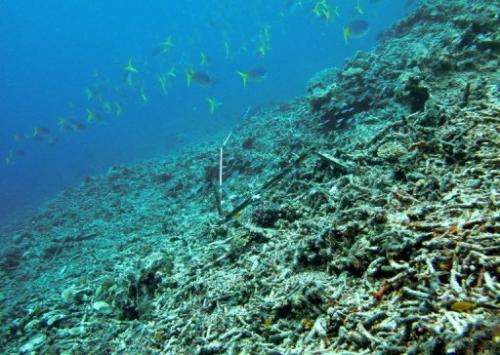Starfish threatens famed Philippine coral reefs

A coral-killing starfish has begun infesting a channel of water in the Philippines famed for having some of the most diverse marine life in the world, the government said Friday.
The appearance of the crown-of-thorns starfish in the Verde Island Passage could cause great damage to the area's biodiversity, Jacob Meimban, head of the wildlife bureau's coastal marine management office, told AFP.
"The crown-of-thorns starfish really kills the corals. It eats the polyps of the corals, leaving the bleached, white bodies. Then it moves elsewhere... until it leaves the reef dead," Meimban said.
Marine biologists have described the passage, which is 100 kilometres (around 60 miles) long and 20 kilometres wide, as the "centre of the centre" of the world's ocean biodiversity.
It is at the top of the Coral Triangle, an area of water spanning down to Indonesia, Papua New Guinea and East Timor that is called the "Amazon of the Seas" because of its rich marine life.
However environmentalists have also warned for years that the passage, a popular dive location, is under grave threat from pollution and overfishing.
It is one of the busiest waterways in the Philippines, with its waters plied daily by oil and chemical carriers. On nearby shores there are shipyards, chemical, oil refineries and big populations.
Meimban said the starfish had been detected in large numbers for the first time in recent months.
He said they may have boomed because of overfishing, which removed many of its natural predators, and siltation, which brings nutrients to the sea that encourage their growth.
He said two dives in the Verde Island passage since April had found at least 500 square metres (around 5,400 square feet) of corals ruined by the starfish, but they did not have enough divers to determine the full extent of the damage.
The wildlife bureau has tapped local volunteers, university students and the coastguard for divers to start removing the starfish.
"But we need more divers," he said.
Removing the starfish requires divers to laboriously pick them up one-by-one with metal tongs, then bring them to shore for burial, he said.
Marine biologists say the crown-of-thorns starfish has been a recurring threat to coral reefs around the world for decades.
The Australian government said in March it had spent more than $1.4 million to cull 60,000 of them on the Great Barrier Reef.
© 2013 AFP




















